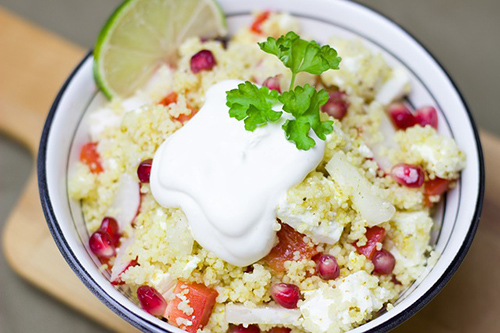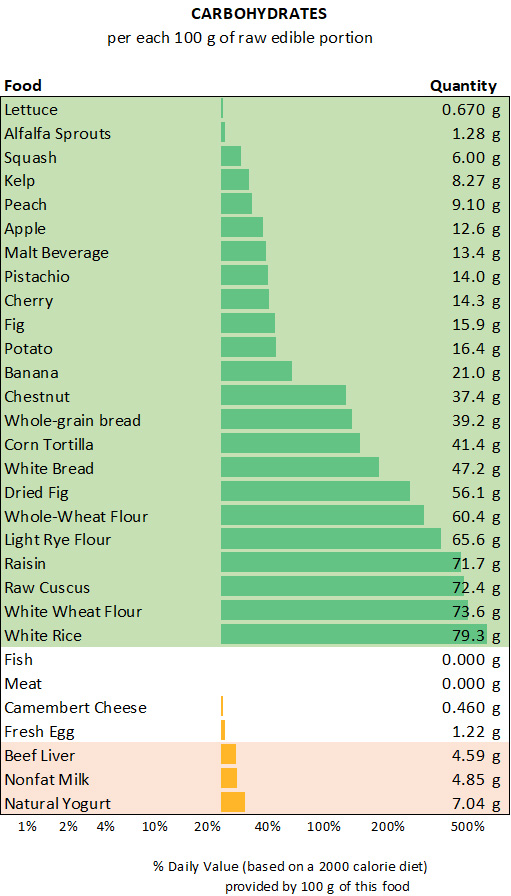Contents

The following list of carbohydrate foods is almost exclusively plant-based and contains the nutrients most needed by the body. Grains, legumes, and tubers are the best sources of carbohydrates (the most healthful); fruits and honey are the best sources of simple carbohydrates (sugars).
Carbohydrates, as the word suggests, combine carbon and water. For each atom of carbon, there is one molecule of water. However, the word carbohydrate does not name just one thing. Instead, it identifies a large group of substances, some of which are poorly understood. The most common carbohydrates of nutritional importance are sugars, starches, and dietary fiber.
Chemical composition and sources: Carbohydrates are a broad group of substances in plant-based foods.
Absorbable carbohydrates are those that the body can assimilate and transform into energy.
Types of Carbohydrates

- Simple: the most abundant simple carbohydrates in foods are monosaccharides (glucose and fructose) and disaccharides (saccharose or ordinary sugar, maltose, lactose, or milk sugar). These are the so-called sugars. They are found primarily in fruits and honey.
- Complex: These are polysaccharides, whose molecule is formed by the union of thousands of monosaccharide molecules. They are starch (abundant in grains, legumes, and tubers) and glycogen (found in small, nutritionally insignificant amounts in the liver and meat of animals).
The starch in grains (particularly whole grains) and legumes is slowly transformed into glucose in the intestine without provoking an abrupt increase in glycemia (blood sugar level). Starch is preferable to sugars. It is the most healthful of carbohydrates and the best tolerated by people with diabetes.
Non-absorbable carbohydrates: This is dietary fiber.

Carbohydrates function: Carbohydrates constitute the primary source of energy for the body. Consequently, it is essential to include abundant plant-based meals based on the following list of carbohydrate foods since they are almost the only source of carbohydrates.
Deficiency symptoms: Ketosis (acidification of the blood), internal consumption of proteins, mineral loss, dehydration. This occurs in diets rich in animal-based proteins and fats but lacking plant-based healthy carbohydrate foods.
Consequences of excess: Malnutrition with farinaceous dystrophy in children.
Increased need: physical exercise, growth periods.
Loss of carbohydrates during the processing of foods: virtually none.
List of Carbohydrate Foods

Carbohydrates, found almost exclusively in plant-based foods, are the nutrients most needed by the body. Grains, legumes, and tubers are the best sources of carbohydrates (the most healthful); fruits and honey are the best sources of simple carbohydrates (sugars).
Recommended Daily Intake of Carbohydrates
The average for an adult is 300 grams a day for a 2000-calorie diet (375 g for a 2500-calorie diet). This supposes that 60% of daily caloric intake must come from carbohydrates.
Most of these carbohydrates must be complex (polysaccharides). Refined sugars must not take up more than 10% of total calories (50 g of sugar a day maximum).
DISCLAIMER: All content on this website is presented solely for educational and informational objectives. It would be best to not rely on the information provided as a replacement for advice, diagnosis, or treatment from a qualified medical expert. If you are pregnant, nursing, or have any preexisting medical concerns, you should talk to your doctor before using any herbal or natural medicines.
REFERENCES
- George D. Pamplona-Roger, M.D. “Encyclopedia of Foods and Their Healing Power.” George D. Pamplona-Roger, M.D. Encyclopedia of Foods and Their Healing Power. Trans. Annette Melgosa. Vol. 1. Chai Wan: Editorial Safeliz, 2005.387. Print.
- Hardinge, Mervyn G and Harold Shryock. “Family Medical Guide.” Hardinge, Mervyn G and Harold Shryock. Family Medical Guide. Ed. Marvin Moore and Bonnie Tyson-Flynn. Vol. one. Oshawa; Washington, D.C.; Hagerstown: Pacific Press Publishing Association; Review and Herald Publishing Association, 1999. Three vols. 103. Print. [list of carbohydrate foods]
